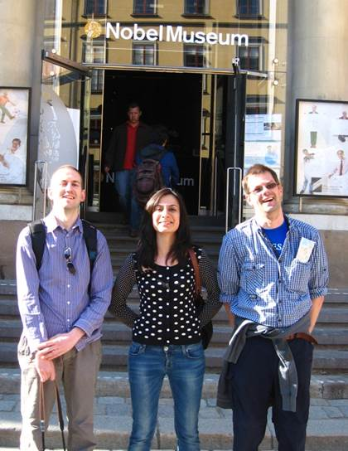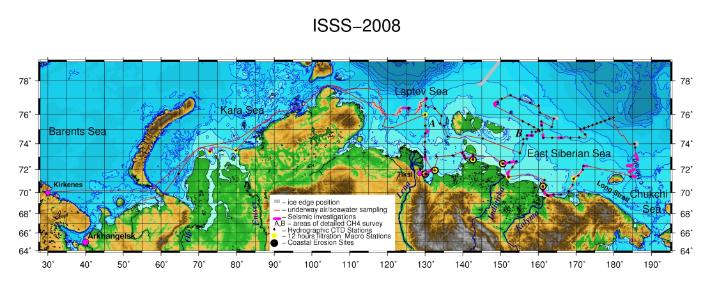Eurasian Arctic Carbon Cyling
Effects of a warming climate on the key organic carbon cycle processes in the Eurasian Arctic (NERC NE/I027967/1)
This is a joint project with PI Dr Bart. E. van Dongen,
Co-Investigators Robert Sparkes, Ayca Doğrul Selver and Bart E. van Dongen

The University of Manchester Organic Geochemistry Group

Project Summary
The Earth is warming but forecasts indicate that the fastest warming regions on the planet are close to the poles. The Siberian region in particular is experiencing one of the largest warming trends on Earth. The EurasianArctic, containing one of the largest carbon reservoirs on the globe trapped by permafrost, might therefore be at risk. Amplified warming could cause a general reduction of the total volumeof permafrost causing the remobilization of large amounts of this trapped carbon. It is presently unclear to what extent this remobilization is already happening and what will happen to this carbon after it is transported off the permafrost areas to the Eurasian Arctic Shelf (EAS). In addition, as stated by Prof. Chris Rapley, on the NERC website 'the polar regions are an integral part of the machinery of this planet' meaning that changes in the Arctic region have potential feedbacks to the entire global carbon-climate system. Therefore if we want to understand the effects of climate warming on the global carbon cycle we must understand the processes occurring in the Arctic region, making the EAS a highly important area for research. However, this is an understudied region, mostly due to limited access to non-Russian scientists, and research is currently limited by the availability of good representative samples from this region.
In the summer of 2008, state of the art sampling ofboth sediments and the overlying water column was performed during the ISSS-08 expedition along the entire EAS seaboard as well as over detailed cross-shelf transects, both off Russian Arctic Rivers and areas of extensive coastal erosion. This also included areas with high methane concentrations in the water column. The PI participated in the cruise in collaboration with a group of internationally renowned scientists from Sweden, Russia, the United Kingdom and the USA.
We will use the sediments collected for this internationally competitive research program to study (1)the fate of the vastamounts of terrestrial carbon currently liberated from the Russian Arctic tundra/taiga areas, and transported to Arctic shelf regions by the Russian Arctic rivers and through coastal erosions and (2) the effects of climate warming on the remobilization and degradation, of this material onthe EAS, ultimately to the greenhouse gases carbondioxide and also methane, which is already being released from melting subsurface permafrost.
In this project we are collaborating with a Pan-Arctic group of researchers. The contribution from theUK group, lead by the University of Manchester, will initially focus on the testing of hypotheses associated with the (climate induced) remobilization and degradation of the macromolecular part of the terrestrial carbon, such as polysaccharides and polypeptides. We will analyse the composition of this macromolecular material allowing us to determineif and to what extent (part of) this carbon is microbiolically degraded on transport. In addition, using techniques such as off-line pyrolysis and preparative capillary gas chromatography, we will isolate enough material for radiocarbon dating. This will allow us to determine the reservoir/residence time (age) of themacromolecular material. We will combine the results of these analyses with those of the other Pan-Arctic partners and deliver an improved terrestrial organic carbon budget for the eastern EAS.
In addition, to make maximum use of a unique sampleset, we will also investigate the significance (the source, transport and fate) of organic material produced or recycled by microorganisms, including the greenhouse gas methane. This will be carried out at Newcastle University. Finally thesamples will also form the bases for future research proposals and collaborations with an international network of scientists working at the forefront of Arctic research, ultimately leading to many new interdisciplinary research projects.
PUBLICATIONS
Doĝrul Selver, A., Sparkes, R.B., Bischoff, J., Talbot, H.M., Gustaffson, Ö., Semilitov, I., Dudarev, O., Boult, S., van Dongen, B.E. Distributions of bacterial and archaeal membrane lipids in surface sediments across the Kolyma River transect. Organic Geochemistry. In Review.
Sparkes, R., Doğrul Selver, A., Bischoff, J., Talbot, H.M., Gustafson, O., Semiletov, I., Dudarev, O., van Dongen, B.E. GDGT distributions on the East Siberian Shelf: implications for organic carbon export, burial and degradation. Biogeosciences. In Review.
Doğrul Selver, A., Talbot, H.M., Gustafsson, O, Boult, S., van Dongen B.E., 2012. Soil organic matter transport along a sub-Arctic river-sea transect. Organic Geochemistry 51, 63-72.